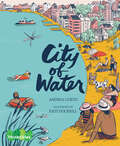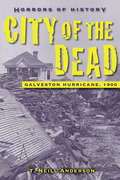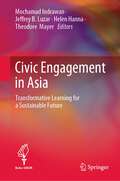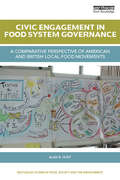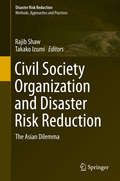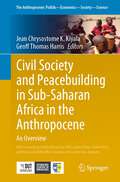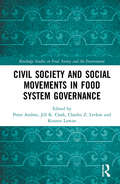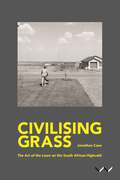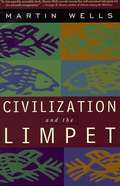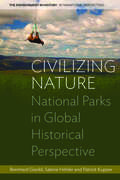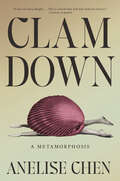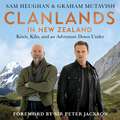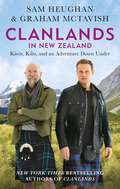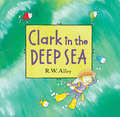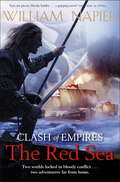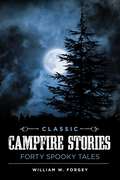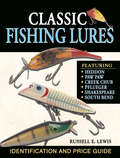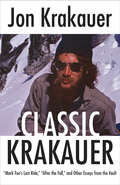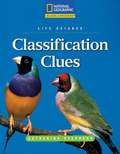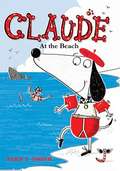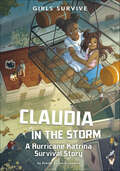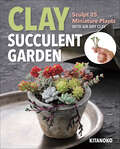- Table View
- List View
City of Water (ThinkCities)
by Andrea CurtisThe second book in the ThinkCities series explores water as a precious, finite resource, tracing its journey from source, through the city, and back again. Living in cities where water flows effortlessly from our taps and fountains, it’s easy to take it for granted. City of Water, the second book in the ThinkCities series, shines a light on the water system that is vital for our health and well-being. The narrative traces the journey of water from the forests, mountains, lakes, rivers and wetlands that form the watershed, through pipes and treatment facilities, into our taps, fire hydrants and toilets, then out through storm and sewer systems toward wastewater treatment plants and back into the watershed. Along the way we discover that some of the earliest cities with water systems date back to the Indus Valley in 2500 BC; that in 1920 only 1 percent of the US population had indoor plumbing; that if groundwater is used up too quickly, the land can actually sink; and more. The text is sprinkled with fun and surprising facts — some water fountains in Paris offer sparkling water, and scientists are working to extract microscopic particles of precious metals found in sewage. Readers are encouraged to think about water as a finite resource, and to take action to prevent our cities and watersheds from becoming more polluted. More than 2 billion people in the world are without access to safe, fresh water at home. As the world’s population grows, along with pollution and climate change, access to clean water is becoming an urgent issue. Includes practical steps that kids can take to help conserve water. The ThinkCities series is inspired by the urgency for new approaches to city life as a result of climate change, population growth and increased density. It highlights the challenges and risks cities face, but also offers hope for building resilience, sustainability and quality of life as young people advocate for themselves and their communities. Correlates to the Common Core State Standards in English Language Arts: CCSS.ELA-LITERACY.RL.3.3 Describe the relationship between a series of historical events, scientific ideas or concepts, or steps in technical procedures in a text, using language that pertains to time, sequence, and cause/effect.
City of the Dead (Horrors of History)
by T. Neill AndersonThe fate of Sam, Charlie, Alice, Daisy, and other Galvestonians hangs in the balance as the flood waters rise during the great hurricane that hit Galveston, Texas, in 1900.
Civic Engagement in Asia: Transformative Learning for a Sustainable Future
by Helen Hanna Mochamad Indrawan Jeffrey B. Luzar Theodore MayerThis book confronts issues relating to climate change and sustainable development innovations in Asia, with attention to key issues and applications in terms of advocacy, governance, citizen science, tradition, faith, leadership, and education. With contributions by 31 leading thinkers from countries in Asia, the book presents issues and poses potential solutions for sustainable development, responding to questions relating to problems prioritized by non-state actors for civic engagement. It also puts forward key strategies and methods used for civic engagement. Drawing from diverse sets of practical and scholarly experience and expertise in geographical and social arenas, authors draw from real-time engagement with specific peoples, often associated with civil society organizations, and conduct an exploration of the essential issue of what the world means in the context of different cultures, thus constructively fusing the two key themes of ecology and anthropology. In doing so, this book enables new ways of thinking about human relationships with nature, relating rich and diverse examples of transformative learning. Co-published with Indonesian press OBOR, this is a vital collection for practitioners and researchers working in areas of ecology, sustainable development, human ecology, governance, geography, environmental science and post-neoliberal economics, particularly in an Asian context. "Civic Engagement in Asia weaves together a set of fascinating stories and examples of sustainable development practice told from the perspectives of non-state actors. Written by a set of top scholars and activists from around the region, it will be an informative read for all those who feel a sense of urgency around the environmental, social, and economic transformations taking place across Asia today” - Celia Lowe, Professor of Anthropology and International Studies, University of Washington, Seattle
Civic Engagement in Food System Governance: A comparative perspective of American and British local food movements (Routledge Studies in Food, Society and the Environment)
by Alan R. HuntThe local food movement is one of the most active of current civil engagement social movements. This work presents primary evidence from over 900 documents, interviews, and participant observations, and provides the first descriptive history of local food movement national policy achievements in the US, from 1976 to 2013, and in the UK, from 1991 to 2013, together with reviews of both the American and British local food movements. It provides a US-UK comparative context, significantly updating earlier comparisons of American, British and European farm and rural policies. The comparative perspective shows that, over time, more effective strategies for national policy change required social-movement building strategies, such as collaborative policy coalitions, capacity-building for smaller organizations, and policy entrepreneurship for joining together separate rural, farming, food, and health interests. In contrast, narrowly-defined single issue campaigns often undermined long-term policy change, even if short-term wins emerged. By profiling interviews of American and English movement leaders, policymakers, and funders, the book demonstrates that democratic participation in food policy is best supported when funders incentivize groups to work together and overcome their differences.
Civil Society Organization and Disaster Risk Reduction: The Asian Dilemma (Disaster Risk Reduction)
by Rajib Shaw Takako IzumiCivil society organizations (CSOs) have played important roles over the years in the disaster field Starting from the traditional approach of response and relief, the emphasis has gradually shifted to disaster risk reduction From international nongovernmental organizations (NGOs) to national and local NGOs, all stakeholders have recognized the significance of and need for community-based risk reduction. In their different capacities they have endeavored to establish links to the policy options at the local and national levels There still are many issues that remain untouched by CSOs, however, and local CSOs face special challenges in resources in terms of human, financial, and technical issues Drawing examples from Asia, this book is structured on the roles of CSOs according to the Hyogo Framework for Action priority areas: policy making, risk assessment, education and training, underlying risk factors, and response-recovery The primary target groups for this book are students and researchers in the fields of environment, disaster risk reduction, and climate change studies The book provides a clear view of the current trends of research in the field and furnishes basic knowledge on these important topics Another target group comprises practitioners and policy makers, who will be able to apply the knowledge collected here to policy and decision making.
Civil Society and Peacebuilding in Sub-Saharan Africa in the Anthropocene: An Overview (The Anthropocene: Politik—Economics—Society—Science #34)
by Jean Chrysostome K. Kiyala Geoff Thomas HarrisThis book examines civil society's peacebuilding role in sub-Saharan Africa in the contextof climate change and the pursuit of environmental peace and justice in the Anthropocene.Five main research themes emerge from its 20 chapters:· The roles of environmental peacemaking, environmental justice, ecologicaleducation and eco-ethics in helping to mitigate the impacts of climate change· Peacebuilding by CSOs after violent conflicts, with particular reference toaccountability, reconciliation and healing· CSO involvement in democratic processes and political transition after violentconflicts· Relationships between local CSOs and their foreign funders and the interactionsbetween CSOs and the African Union's peace and security architecture.· The particular role of faith-based CSOsThe book underlines the centrality of dialogue to African peacebuilding and the indigenouswisdom and philosophies on which it is based. Such wisdom will be a key resource inconfronting the existential challenges of the Anthropocene.The book will be a significant resource for researchers, academics and policymakersconcerned with the challenge of climate change, its interactions with armed conflict and thepeacebuilding role of CSOs.· This pathbreaking book shows why peacebuilding analysis and efforts need to beurgently re-oriented towards the existential challenges of environmental peace andjustice.· It explains the emerging conceptual frameworks which are needed for this new role.· It explains the critical role that CSOs - local and international - will play inimplementing this new peacebuilding approach, with particular reference to sub-Saharan Africa.
Civil Society and Social Movements in Food System Governance (Routledge Studies in Food, Society and the Environment)
by Charles Z. Levkoe Kristen Lowitt Peter Andrée Jill K. ClarkThis book offers insights into the governance of contemporary food systems and their ongoing transformation by social movements. As global food systems face multiple threats and challenges there is an opportunity for social movements and civil society to play a more active role in building social justice and ecological sustainability. Drawing on case studies from Canada, the United States, Europe and New Zealand, this edited collection showcases promising ways forward for civil society actors to engage in governance. The authors address topics including: the variety of forms that governance engagement takes from multi-stakeholderism to co-governance to polycentrism/self-governance; the values and power dynamics that underpin these different types of governance processes; effective approaches for achieving desired values and goals; and, the broader relationships and networks that may be activated to support change. By examining and comparing a variety of governance innovations, at a range of scales, the book offers insights for those considering contemporary food systems and their ongoing transformation. It is suitable for food studies students and researchers within geography, environmental studies, anthropology, policy studies, planning, health sciences and sociology, and will also be of interest to policy makers and civil society organisations with a focus on food systems.
Civilising Grass: The art of the lawn on the South African Highveld
by Jonathan CaneCivilising Grass is a socio-cultural analysis of the lawn on the South African highveld, exploring the complex relationship between landscape and power in the country’s colonial, modernist and post-apartheid erasDrawing from eco-criticism, queer theory, art history and postcolonial studies, this book offers a lively and provocative reading of texts and illustrations to reveal the racial and gendered aspects of ‘natural’ environments. It argues that the lawn, an ordinary and often overlooked feature of South African everyday life, is neither natural nor innocent. Rather, like other colonial landscapes, the lawn functions as a site of commonplace violence, of oppression, dispossession and segregation. This book explores an eclectic archive of artistic, literary and architectural lawns between 1886 and 2017, analysing poems, maps, gardening blogs, adverts, ethnographies and ephemera, as well as literature by Koos Prinsloo, Marlene van Niekerk and Ivan Vladislavic. In addition, Civilising Grass includes colour reproductions of lawn artworks by David Goldblatt, Lungiswa Gqunta, Pieter Hugo, Anton Kannemeyer, Sabelo Mlangeni, Moses Tladi and Kemang Wa Lehulere. Examination of these and other works reveals the organic relationship between lawn and wildness, and between lawn and human/non-human actors – thereby providing rich and unexpected insights into South African society past and present.
Civilization and the Limpet
by Martin WellsIn 25 non-technical essays conceived during an ocean voyage from England to the Mediterranean, Wells (marine biology, Cambridge U.) reflects on the diversity and tenacity of life in the sea. Besides the seemingly unintelligent limpet always returning to the exact same spot, he describes sea urchins making survival decisions, so called deserted islands teeming with animal life, and whales diving deep and surface without getting the bends. He includes an index but no bibliography. Annotation c. Book News, Inc., Portland, OR (booknews.com)
Civilizing Nature
by Patrick Kupper Sabine Hohler Bernhard GissiblNational parks are one of the most important and successful institutions in global environmentalism. Since their first designation in the United States in the 1860s and 1870s they have become a global phenomenon. The development of these ecological and political systems cannot be understood as a simple reaction to mounting environmental problems, nor can it be explained by the spread of environmental sensibilities. Shifting the focus from the usual emphasis on national parks in the United States, this volume adopts an historical and transnational perspective on the global geography of protected areas and its changes over time. It focuses especially on the actors, networks, mechanisms, arenas, and institutions responsible for the global spread of the national park and the associated utilization and mobilization of asymmetrical relationships of power and knowledge, contributing to scholarly discussions of globalization and the emergence of global environmental institutions and governance.
Claiming the Royal Innocent: An Emotional and Sensual Romance (Kingdoms & Crowns #2)
by Jennifer HaywardFound When Aleksandra Dimitriou is revealed as the secret daughter of Akathinia's former king, she's torn from her comfortable existence and thrust into the royal world...under the protection of Aristos Nicolades. Forbidden Aristos has orders not to touch the innocent princess, but beautiful Aleksandra calls to the rebellious urges that the self-made Greek tycoon thought he overcame long ago. Forever? As the heat of their desire rises, the rules begin to evaporate. It's soon clear that the person Aristos should be protecting Aleksandra from is himself!
Clam Down: A Metamorphosis
by Anelise ChenIn this wondrously unusual memoir, a woman retreats into her shell in the aftermath of her divorce, and must choose between the pleasures and the perils of a closed-up life—a transformation fable from an acclaimed 5 Under 35 National Book Foundation honoree.&“A marvel and a delight . . . This is a book that will stay with me forever.&”—Leslie Jamison, author of SplintersWe&’ve all heard the story about waking up as a cockroach—but what if a crisis turned you into a clam? After the dissolution of her marriage, a writer is transformed into a &“clam&” via typo after her mother keeps texting her to &“clam down.&” The funny if unhelpful command forces her to ask what it means to &“clam down&”—to retreat, hide, close up, and stay silent. Idiomatically, we are said to &“clam up&” when we can&’t speak, and to &“come out of our shell&” when we reemerge, transformed.In order to understand her path, the clam digs into examples of others who have embraced lives of reclusiveness and extremity. Finally, she confronts her own &“clam genealogy&” to interview her dad, who disappeared for a decade to write a mysterious accounting software called Shell Computing. By excavating his past to better understand his decisions, she learns not only how to forgive him but also how to move on from her own wounds of abandonment and insecurity.Using a genre-defying structure and written in novelistic prose that draws from art, literature, and natural history, Anelise Chen unfolds a complex story of interspecies connectedness, in which humans learn lessons of adaptation and survival from their mollusk kin. While it makes sense in certain situations to retreat behind fortified walls, the choice to do so also exacts a price. What is the price of building up walls? How can one take them back down when they are no longer necessary?
Clanlands in New Zealand: Kiwis, Kilts, and an Adventure Down Under
by Sam Heughan Graham McTavish*With a foreword by Sir Peter Jackson*Buckle up, grab a dram, and get ready for another unforgettable wild ride.They're back! Stars of Outlander, Sam Heughan and Graham McTavish are no strangers to the rugged beauty of Scotland. But this time they're setting their sights on a new horizon: New Zealand.Join our intrepid Scotsmen on their latest epic adventure across The Land of the Long White Cloud in this thrilling follow-up to Clanlands. Setting out to explore a country that Graham calls home, and that Sam has longed to visit, these sturdy friends immerse themselves in all that New Zealand has to offer: stunning landscapes, rich history, world-class food and drink, and - much to Graham's mounting anxiety and Sam's deep satisfaction - famously adrenaline-fuelled activities! As ever there's not nearly enough space in their trusty camper van and with plenty of good-natured competition and tormenting to go around, Sam and Graham's friendship is put to the test once again. Along the way we learn about the length and breadth of this jewel of the Southern Seas, exploring the fascinating story of its people while testing the very limits of Graham's sanity.Like the very best buddy movie sequel, this latest instalment is full of unforgettable experiences and loveable characters and promises to be an even more memorable ride with two of the most entertaining travel companions around.So, say goodbye to your inhibitions and kia ora to New Zealand like you've never seen it before.(p) 2023 Hachette Audio US
Clanlands in New Zealand: Kiwis, Kilts, and an Adventure Down Under
by Sam Heughan Graham McTavish*With a foreword by Sir Peter Jackson*Buckle up, grab a dram, and get ready for another unforgettable wild ride.They're back! Stars of Outlander, Sam Heughan and Graham McTavish are no strangers to the rugged beauty of Scotland. But this time they're setting their sights on a new horizon: New Zealand.Join our intrepid Scotsmen on their latest epic adventure across The Land of the Long White Cloud in this thrilling follow-up to Clanlands. Setting out to explore a country that Graham calls home, and that Sam has longed to visit, these sturdy friends immerse themselves in all that New Zealand has to offer: stunning landscapes, rich history, world-class food and drink, and - much to Graham's mounting anxiety and Sam's deep satisfaction - famously adrenaline-fuelled activities! As ever there's not nearly enough space in their trusty camper van and with plenty of good-natured competition and tormenting to go around, Sam and Graham's friendship is put to the test once again. Along the way we learn about the length and breadth of this jewel of the Southern Seas, exploring the fascinating story of its people while testing the very limits of Graham's sanity.Like the very best buddy movie sequel, this latest instalment is full of unforgettable experiences and loveable characters and promises to be an even more memorable ride with two of the most entertaining travel companions around.So, say goodbye to your inhibitions and kia ora to New Zealand like you've never seen it before.
Clanlands in New Zealand: Kiwis, Kilts, and an Adventure Down Under
by Sam Heughan Graham McTavish*With a foreword by Sir Peter Jackson*Buckle up, grab a dram, and get ready for another unforgettable wild ride.They're back! Stars of Outlander, Sam Heughan and Graham McTavish are no strangers to the rugged beauty of Scotland. But this time they're setting their sights on a new horizon: New Zealand.Join our intrepid Scotsmen on their latest epic adventure across The Land of the Long White Cloud in this thrilling follow-up to Clanlands. Setting out to explore a country that Graham calls home, and that Sam has longed to visit, these sturdy friends immerse themselves in all that New Zealand has to offer: stunning landscapes, rich history, world-class food and drink, and - much to Graham's mounting anxiety and Sam's deep satisfaction - famously adrenaline-fuelled activities! As ever there's not nearly enough space in their trusty camper van and with plenty of good-natured competition and tormenting to go around, Sam and Graham's friendship is put to the test once again. Along the way we learn about the length and breadth of this jewel of the Southern Seas, exploring the fascinating story of its people while testing the very limits of Graham's sanity.Like the very best buddy movie sequel, this latest instalment is full of unforgettable experiences and loveable characters and promises to be an even more memorable ride with two of the most entertaining travel companions around.So, say goodbye to your inhibitions and kia ora to New Zealand like you've never seen it before.
Clark in the Deep Sea
by R. W. AlleyClark and his brother and sisters are stuck on their front porch on a rainy spring day. When a stuffed bear is flung off the porch into a puddle, the backyard becomes an ocean, and Clark, with some help from his siblings, embarks on a deep-sea diving rescue mission. Full of classic charm, this satisfying fantasy is one of four small books each starring a different sibling and season by the children's book veteran R. W. Alley. Look for Mitchell on the Moon and Annabelle at the South Pole in Fall 2016.
Clash of Empires: The Red Sea
by William NapierTwo unlikely English heroes are swept up in an epic and bloody sea battle that will change history.1571. Chained to a slave galley in the heart of the Mediterranean, it seems that English adventurers Ingoldsby and Hodge might have finally run out of luck. But they've survived worse, and as the men around them drop dead at their oars, they're determined to escape.By a miracle of fate, they find their way back to dry land and freedom - but unable to return home. With the Ottoman Empire set on strangling the crusading Christian power before it can take root, hostilities between East and West - Muslim and Christian - are vicious and deadly. And as the sun rises on one day in October, five hours of bloodshed will change the course of history. Once again, the two Englishmen find themselves living on borrowed time...
Classic Campfire Stories: Forty Spooky Tales
by William W. Forgey M.D.Need a good scary story to tell to youngsters—or to anyone, young or old, who wants a little fright before going off to sleep in the great outdoors? Nothing goes better with gooey s&’mores and a glowing campfire than a good ghost story, and this collection of Doc Forgey&’s best scary classics and frightening folktales will send shivers up anyone&’s spine. Classic Campfire Stories includes forty classic stories of adventures and ghosts, all fun and easy to remember and retell. Read about:The Valley of the Blue MistThe Human HandLa Cucaracha MineThe PartnerThe Mackenzie River GhostThe Death of the Old LionThe Ice Walker only in 1985 versionThe MessageThe Haunting of the House on the Ridge
Classic Fishing Lures: Identification and Price Guide
by Russell LewisCovering the collectible lures of the six most popular lure manufacturers in North America - Heddon, South Bend, Paw Paw, Pflueger, Creek Chub and Shakespeare, this full-color book is the most comprehensive identification and price guide available! This book features a history of each manufactures, with nearly 2,000 listings of the most collectible lures on the market, complete with up-to-date pricing and a brilliant color photos. No collector will want to be without this glorious tribute to the fishing lures of yesterday.
Classic Krakauer: Mark Foo's Last Ride, After the Fall, and Other Essays from the Vault
by Jon KrakauerThe gripping articles in Classic Krakauer, originally published in periodicals such as The New Yorker, Outside, and Smithsonian, display the singular investigative reporting that made Jon Krakauer famous—and show why he is considered a standard-bearer of modern journalism. Spanning an extraordinary range of subjects and locations, these articles take us from a horrifying avalanche on Mt. Everest to a volcano poised to obliterate a big chunk of greater Seattle at any moment; from a wilderness teen-therapy program run by apparent sadists to an otherwordly cave in New Mexico, studied by NASA to better understand Mars; from the notebook of one Fred Beckey, who catalogued the greatest unclimbed mountaineering routes on the planet, to the last days of legendary surfer Mark Foo. Rigorously researched and vividly written, marked by an unerring instinct for storytelling and scoop, the pieces in Classic Krakauer are unified by the author’s ambivalent love affair with unruly landscapes and his relentless search for truth.
Classification Clues
by Catherine StephensIntroduces the basics of classification for plants and animals, with a history of the system devised by Linnaeus, and hands-on exercises in classification.
Claude At The Beach (Claude Series)
by Alex T. SmithClaude is no ordinary dog ? he leads an extraordinary life! Claude and his best friend, Sir Bobblysock (who is both a sock and very bobbly), pack their bags and go on vacation to the beach. They rescue a man from a shark, win a sandcastle-building competition, and hunt for pirate treasure. Of course, they make it back home just before Mr. and Mrs. Shinyshoes come home from work. Quirky, delightfully odd, and positively surreal, Alex T. Smith's illustrated early chapter book series promises giggle-filled bedtime reading and a laugh-out-loud option for readers transitioning from picture books to chapter books.
Claudia in the Storm: A Hurricane Katrina Survival Story (Girls Survive)
by Denise Walter McConduitWith Hurricane Katrina on track to hit New Orleans, twelve-year-old Claudia and her family are preparing to weather the storm. But nothing can prepare them for the awful flooding that occurs when the levees that surround the city fail. Even worse, after a chaotic helicopter evacuation, Claudia and her younger sister become separated from the rest of their family. Now it is up to Claudia to protect and comfort her sister through the tragedy. Readers can learn the real story of the Hurricane Katrina from the nonfiction back matter in this Girls Survive story. A glossary, discussion questions, and writing prompts are also provided.
Clay Succulent Garden: Sculpt 25 Miniature Plants with Air-Dry Clay
by KitanokoBecome a forever plant parent with your own craft-savvy garden! Lacking a green thumb? There’s no need to worry when you can create your own everlasting succulents with versatile air-dry clay. Designs are included for over 25 popular succulent species, such as sedum, echeveria, and haworthia, and unique plants like cacti, air plants, and the Venus flytrap. Each design comes with detailed step-by-step instructions and color photos showing how to make the project from start to finish. You’ll also learn special techniques for creating custom clay colors, sculpting wire supports, and painting finishing details. Each project includes step-by-step color photos to create realistic looking designs Quirky and cute air-dry clay creations for over 25 popular succulent species Perfect for anyone who loves succulents, proud plant parents, miniature enthusiasts, dollhouse makers, and more
